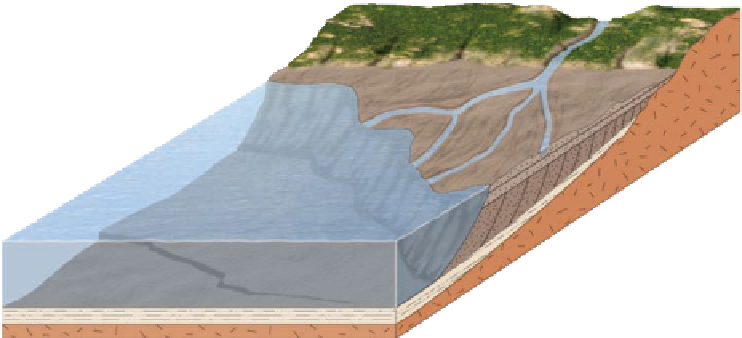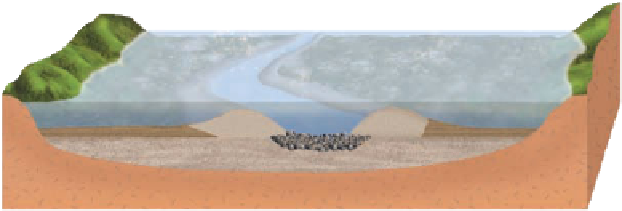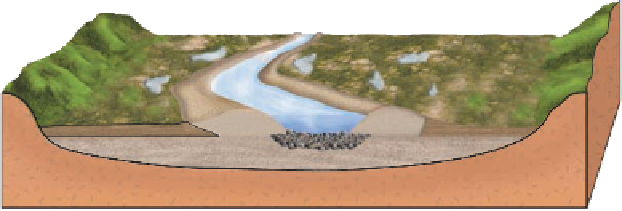Geology Reference
In-Depth Information
much larger, far more complex, and consider-
ably more important as potential areas of natu-
ral resources. In fact, depending on the relative
importance of stream (or river), wave, and tide
processes, geologists identify three main types of
marine deltas (
◗
Figure 12.13
Floodplain Deposits
Deposition
(lateral accretion)
Erosion
Figure 12.15).
Stream-dominated
deltas
have long fi ngerlike sand bodies, each de-
posited in a distributary channel that progrades
far seaward. The Mississippi delta is a good ex-
ample. In contrast, the Nile delta in Egypt is
wave
dominated.
It also has distributary channels, but
the seaward margin of the delta consists of is-
lands reworked by waves, and the entire margin
of the delta progrades.
Tide-dominated deltas
are
continuously modified into tidal sand bodies
that parallel the direction of tidal fl ow.
◗
a
Floodplain deposits formed by lateral accretion of point bars are made up
mostly of sand.
Fan-shaped deposits of alluvium on land known
as
alluvial fans
form best on lowlands with ad-
jacent highlands in arid and semiarid regions
where little vegetation exists to stabilize surface
materials (
Floodplain
Figure 12.16). During periodic rain-
storms, surface materials are quickly saturated
and surface runoff is funneled into a mountain
canyon leading to adjacent lowlands. In the
mountain canyon, the runoff is confi ned so that
it cannot spread laterally, but when it discharges
onto the lowlands, it quickly spreads out, its
velocity diminishes, and deposition ensues. Re-
peated episodes of sedimentation result in the
accumulation of a fan-shaped body of alluvium.
Deposition by running water in the man-
ner just described is responsible for many
alluvial fans. In this case, they are composed
mostly of sand and gravel, both of which con-
tain a variety of sedimentary structures. In
some cases, though, the water fl owing through
a canyon picks up so much sediment that it
becomes a viscous debris flow. Consequently,
some alluvial fans consist mostly of debris-fl ow
◗
Channel
Natural levees
b
The origin of vertical accretion deposits. During fl oods, streams deposit natural
levees, and silt and mud settle from suspension on the fl oodplain.
Floodplain
Channel
Natural levees
After fl ooding.
c
Topset
beds
Distributary
channel
Lake
Foreset
beds
◗
Figure 12.14
Prograding
Delta Internal structure of the
simplest type of prograding delta.
Small deltas in lakes may have this
structure, but marine deltas are
much more complex.
Bottomset
beds













Search WWH ::

Custom Search